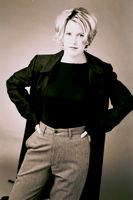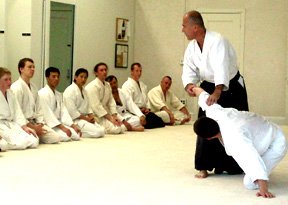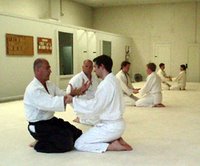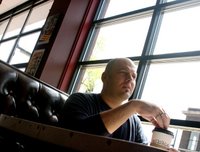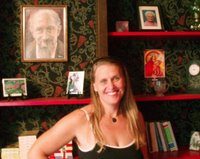 It’s a beautiful day in mid-August when Diana Knobel and I finally meet at The Well on 2100 First Ave. S., where her spiritual counseling practice is located. The building is one of those charming old mansions in a neighborhood that highlights the Minneapolis of both yesterday and today. The dominant vision here is that of the neighborhood as a renewable resource, with enterprises both new and old in vibrant co-existence with one another. F.Scott Fitzgerald meets Nuruddin Farah.
It’s a beautiful day in mid-August when Diana Knobel and I finally meet at The Well on 2100 First Ave. S., where her spiritual counseling practice is located. The building is one of those charming old mansions in a neighborhood that highlights the Minneapolis of both yesterday and today. The dominant vision here is that of the neighborhood as a renewable resource, with enterprises both new and old in vibrant co-existence with one another. F.Scott Fitzgerald meets Nuruddin Farah.Knobel invites me to explore the building’s old world charm as she fixes herself a cup of tea. Then we settle into a plush sofa in her office, which is decorated in soothing colors. The shelves are a study of Knobel’s spiritual teaching lineage, with portraits of teachers who pioneered methods in forgiveness, including notables like Mary Hayes-Greco, Edith Stouffer, and Roberto Assagioli. In addition to being a spiritual counselor, Knobel is a filmmaker and mother of three.
Drano for the Soul
Knobel’s counseling practice focuses on practical spirituality: forgiveness. Learning to forgive is done on an individual level, says Knobel, and “it’s like Drano for the soul. The effect is like burning a log in the fireplace. It’s done. The result is freedom. It doesn’t mean that you condone or allow misbehavior. It’s about understanding.”
“Let me put it this way,” says Knobel, “The definition of insanity is doing the same thing over and over again and expecting a different result. You can’t expect somebody else to do something different. True freedom comes when you change yourself.”
Having struggled through what she calls, “a dysfunctional childhood,” Knobel worked hard to break out of the mistakes her own parents had made with her. She says, “I suffered horribly from low self esteem. I coasted through high school. I was dealing with the divorce of my parents. I regret not taking that more seriously. When I look back on that period – at eighteen, I was at the peak of my intellectual ability, but I had no support structure. There was no one there to channel me.”
At eighteen, Knobel began searching for “where to land” and enrolled in a Bible college, where she studied for two and a half years. “I was a bible thumper for six months of my life,” says Knobel, “I thought, ‘I’ll try this God thing because my life isn’t working now.’ I jumped in with both feet.”
Within twenty-four hours of attending North Central Bible College, Knobel entered into a “born-again experience.” She stopped smoking, drinking, and participating in sexual activity. “It felt nice to come into the city with the feeling that God was watching over us.”
After a while, the experience became almost cult-like, says Knobel, who felt that the overarching message was that, “It’s not going to be safe if you leave the protection of this circle.” Knobel started feeling increasingly uncomfortable with the born-again lifestyle and reflects now that, “You can’t put God into a box and say that spirituality includes only this and this, only what is within these four walls.”
“I’m not a fatalist in any sense of the word, but there is some thread of rhyme or reason in our lives. There does seem to be destiny and free will can sign us up for it.”
The experience was a worthwhile one for Knobel in the sense that it gave her insight into “what Christianity was meant to be and what it has become…an understanding of the Right Wing political movement and how to go head to head with that. Bible college was a part of the preparation.”
Each Choice has a Consequence
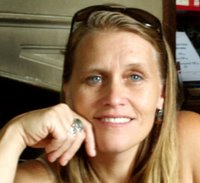 Knobel switches gears for a moment and says, “The first movie that ever impacted my life was Jewel of the Nile, with Kathleen Turner. I was a budding feminist at that time. The patriarchal hierarchy was grating on me, but I didn’t have the language to deal with it. I saw Jewel of the Nile and wanted that kind of life that Kathleen Turner’s character had.”
Knobel switches gears for a moment and says, “The first movie that ever impacted my life was Jewel of the Nile, with Kathleen Turner. I was a budding feminist at that time. The patriarchal hierarchy was grating on me, but I didn’t have the language to deal with it. I saw Jewel of the Nile and wanted that kind of life that Kathleen Turner’s character had.”Knobel removed herself from the religious environment and headed for Europe, where she backpacked on her own for nine months. “God didn’t strike me down with thunderbolts, but served as a guide. There were no lightening bolts – but enlightenment.” She learned to rely on her own judgment and intuition and came to think of the experience as an exercise of faith.
While in Spain, Knobel first encountered the Englishman who was to become her husband. “It wasn’t tourist season, so we were the only blondes in Santiago del Campostello. Our heads stuck up above everybody else’s, otherwise we wouldn’t have seen each other.”
The two were married in 1985 and eventually set up residence in North Minneapolis. Knobel spent the next eight years in her near-north neighborhood, where she and her husband worked as property managers for absentee landlords. Over those eight years, they also worked to rehabilitate their own property, an effort that came in handy when they eventually traded it in for a hobby farm in Lino Lakes.
Knobel and her husband had their first child (of three) in 1989. She is grateful to her (now) ex-husband because, for him, “staying home as a mom wasn’t an issue. It was unheard of in the 80s. ECFE (Early Childhood and Family Education) was just starting. Those of us who stayed home were feeling guilty about not being real women – about not having both professional lives and children.”
Her firstborn daughter was premature and spent the first three weeks of her life in an incubator. “It was an intense birth and there was an intensity about parenting. We wanted the best of everything and made the decision that one of us would stay home.”
Years earlier, at the Bible School, a prophet had predicted that Knobel would get married, have children, develop her spiritual gifts, and eventually start her own ministry. Back then she just dismissed the thought. Now she grins and says, “I had been a feminist, wanted a professional life..but this is how it has played out. The prophecy has unfolded. Boom-Bang-Pow.”
Being a mother gave Knobel a chance to explore her gifts. It was an opportunity to “get in touch with my God-self. I listened to that voice inside. I feel like I’m an incredible mother because of trusting that intuition. I’ve worked very hard to have a gentle, loving voice and had moments where I realized, ‘Oh, it’s my job to repeat myself.’ I’ve been up front with my kids about sex and abuse of drugs. It’s important to say, ‘I don’t want this to happen to you.’”
Meanwhile, Knobel says, “Living in North Minneapolis was a trip..the high crime rates, poverty, economic injustice…After a while, you couldn’t even garden in the back yard. It was scary living there with young children, so we decided to get out.”
A good friend of Knobel’s told her about a HUD property in Lino Lakes and Knobel fell in love with the place. It was a hobby farm on five acres of land. Though the house was in terrible shape, Knobel and her husband were well prepared to do repairs. They sold off their property, made a bid on the place, and waited an agonizing three weeks to find out if they got it. “I thought, ‘It’s not OK for you God, to show me something like this and then take it away.’ When we won the bid, it was a turning point for me in trusting that the desires of our heart are not about Satan. It’s God’s way of instructing us what we should do next.”
Knobel and family moved in. The goats moved in three days later. For six years, they milked goats, made their own cheese, sold eggs and milk to whoever wanted it. “It gave me something to chew on as I was raising the kids. It was great for their immune systems, being exposed to a certain layer of germ on you all the time. My kids are all healthy.”
Whenever I feel like I haven’t found a niche, I can look back and say, ‘Well, I’ve raised three amazing kids.’” This past July, Knobel’s oldest daughter departed for a yearlong exchange program in Brazil. “I realized that I had done it. I had launched a happy, healthy human being into the world,” says Knobel.
Over the years, Knobel’s marriage had started unraveling. Issues that weren’t getting resolved in their marriage began to show in work that was not getting done around the house. I thought, “Maybe if we have one more child, that will make it work? It didn’t.”
Although she and her husband generally agreed on how to raise the children, cross-cultural differences made things difficult. Being English, her husband had been brought up with the belief that “you don’t change your status.” It contrasted with Knobel’s American ideal that, “you can be anybody and do anything.”
When Knobel announced that she wanted to go back to school, her husband said that he would not support her. Knobel felt herself being presented with a choice. “If I stayed, I would be an unsatisfied human being without the chance to develop myself more. I voted for divorce.”
“Each choice has a consequence,” says Knobel, “It’s not about reward and punishment.” It’s a method she learned a long time ago through ECFE. When avoiding a power struggle with a child, “you give them two choices and you teach them how to make a good choice.”
Agent of Change
 Knobel now has a B.S. in Visual Technical Communication and The Art of Persuasion, with a minor in Leadership. As someone who strongly identifies herself as being an agent of change, Knobel is interested in the power of symbolism to harness social movements. The Peace sign, religious art in pre-Christian Europe, and Michael Moore’s documentaries are just a few examples from history.
Knobel now has a B.S. in Visual Technical Communication and The Art of Persuasion, with a minor in Leadership. As someone who strongly identifies herself as being an agent of change, Knobel is interested in the power of symbolism to harness social movements. The Peace sign, religious art in pre-Christian Europe, and Michael Moore’s documentaries are just a few examples from history.“We’ve come to a time where society has to choose which path to go down,” says Knobel, paraphrasing an Anishabe tribe prophecy. “We can choose the scorched path, which is brown and well-traveled. Or we can choose the one that is green and lush and unknown.”
Knobel, who has stepped out into the unknown many times in her own life, says, “If there’s one gift that I can offer, it’s to send the message that it’s really ok to embrace the unknown. There are ways of doing it so that you don’t have to suffer. You don’t have to control it all the time. You don’t need to have it materialize in the world to trust that it will work out. If you can do that, things will change on a dime.”
She continues, “Right now, the physical world dominates in our society. Companies don’t treat their employees as assets. People at the top need people at the bottom working as widgets. It’s not sustainable. The emphasis on power and prestige and position has surpassed the ideal of harmony. Decisions are being made by a group of men at the top. There is no equal playing field. There’s no attention to what is happening to the environment. We are playing with our lives. We can’t make decisions without including what happens to the environment, what the economic impact will be.”
Knobel meets regularly with a water group organized by the Women’s International League of Peace and Freedom. Mobilizing to conserve our drinkable water supplies, she says, is priority. If the male dominated world of politics and international business won’t pay attention, then the rest of us need to do something about it. She says, “It’s up to women to get into powerful positions, to figure out how to have voice. The patriarchal method doesn’t work. It’s women, moving in a line, creating the fabric, the network. We’re locked into a system that doesn’t support enlightenment and self-acknowledgement. We have a choice. We are not victims. Wake up or stay asleep.”
When Hurricane Katrina hit, Knobel took her message on the road to help with the relief effort. She brought her video camera and, while assisting with food and supply transport, began filming the spiritual transformations she witnessed along the way. The further south she traveled, the more she felt the seeds of social change in the wind.
“There were people who had nothing, who had lost everything. They were so spent, but filled with contentment with being alive. They understood the value of life. There were volunteers who had everything else, but were searching for meaning in their lives. There were people who were connecting with meaningful work that’s not about getting paid. The consequences of this are incredible.”
Using a massive truck on loan from the Minnesota Family Project with the words “Power to the People” prominently displayed on the back, Knobel joined up with Mission from Minnesota and other relief organzations. “On our first trip down, I trusted that everything would fall into place. We fundraised to keep the truck going. There was food stuck in warehouses. We filled the truck twenty-five times with protein, carbohydrates, water and drove back and forth, trying to distribute in a way that was fair.”
After returning from her sixth trip to the devastated area, Knobel met Jessie Buckner, a man who was looking for someone to help him organized Youth4Nola, a service program that plans to involve inner-city youth in the New Orleans recovery effort. This Thanksgiving holiday, Youth4Nola will send a team of forty volunteers down to New Orleans to pitch in with painting and rebuilding for a week.
The experience is intended to be transformative, says Knobel, and to encourage participants to ask themselves, “How do we deal with chaos in our own background? Why is it easier to go long distance than it is to look into our own backgrounds? People flock to a crisis, because of the possibility for change,” says Knobel, “but how does this happen here? No one wants to talk about racial issues in Minneapolis. There is complacency, apathy as you go further north (away from the Gulf Coast). It’s because society has forgotten.”
Now off on her seventh trip to the devastated area, Knobel has about one hundred hours of footage documenting the changes she is seeing. “Making this film,” she says, “is a way of getting the message out.” She’s hoping that people will start regarding themselves as participants in a bigger picture. “I want people to understand that if they don’t have time or money, they just have to change their light bulbs. Even changing to energy efficient light bulbs can help with global warming. Start making changes in your own personal lives that will help people who are affected by it. Take a proactive and reactive step. Don’t wait until it’s too late, until it’s mandated by the government.”
Visit Diana Knobel's Website
Photos of Diana Knobel by Valerie Borey
Credit goes to Quito Ziegler for the Minnesota Family Project truck

